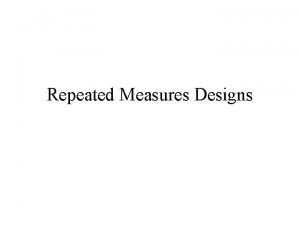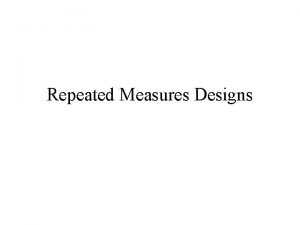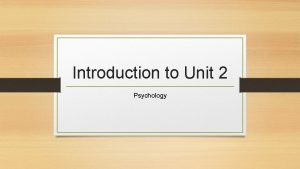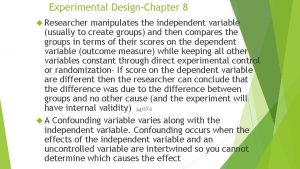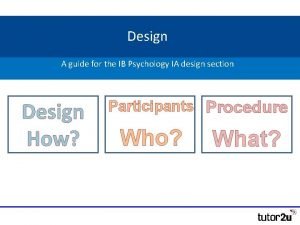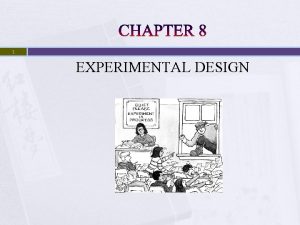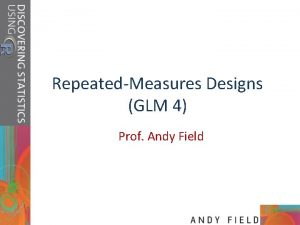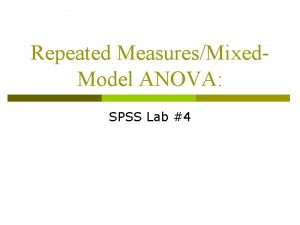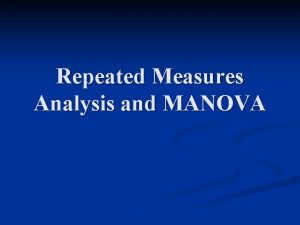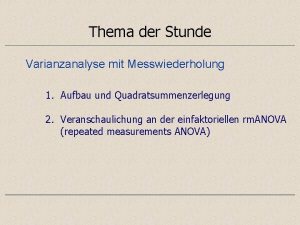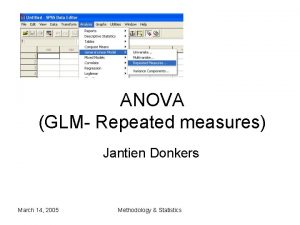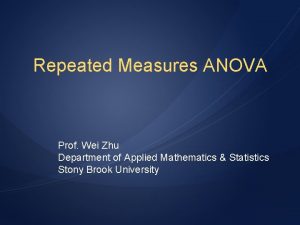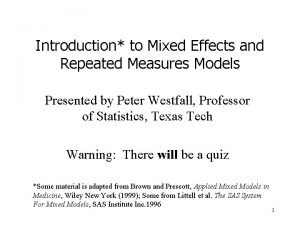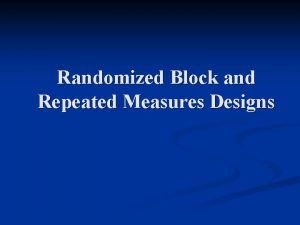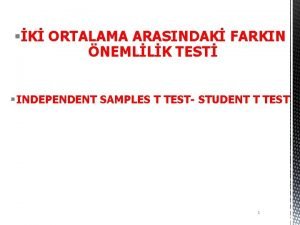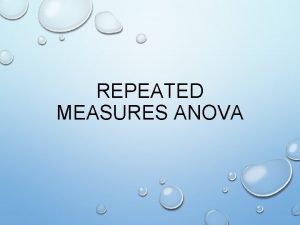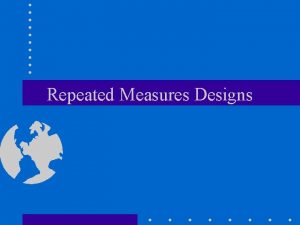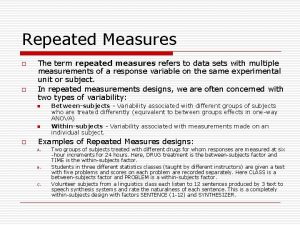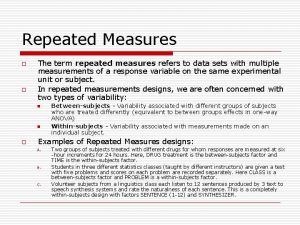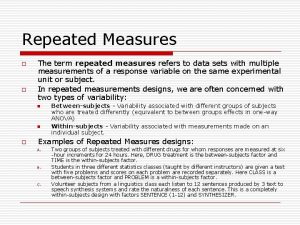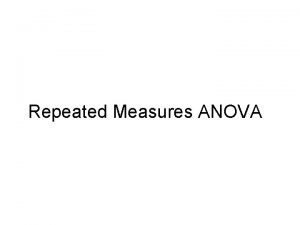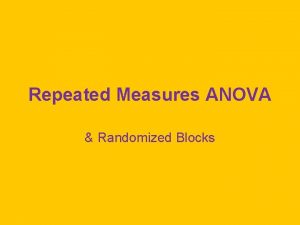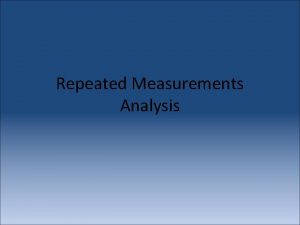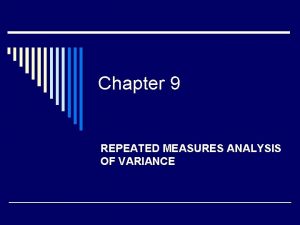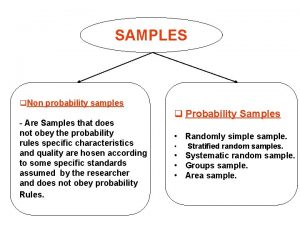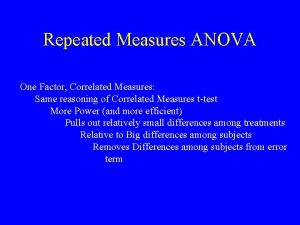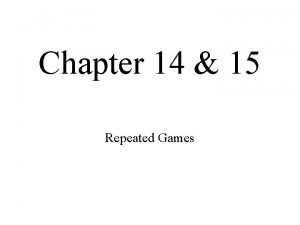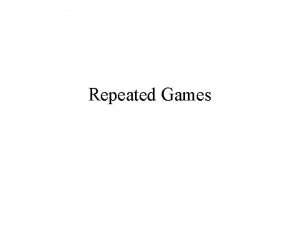Design Considerations Independent Samples v Repeated Measures Independent























- Slides: 23

Design Considerations: Independent Samples v. Repeated Measures • Independent samples design is the canonical situation of control v. experimental treatment, randomly assigned. Even non-scientists feel comfortable with this, except for ethical dilemmas. • Repeated measures is efficient when you want to compare one or more variables (e. g. , responses to questions on a questionnaire) against each other. • Repeated measures is also tactically useful when there is a high degree of individual variation in the measure of interest. You can use each unit / person as its own “control” to look at before-after effects without worrying about individual differences. Concern: contamination by the measurement itself.

Monday, November 12 Statistical Power If you are interested in testing for the statistical significance of an effect that is of a particular magnitude of practical significance, what should the sample size be?

Why Statistical Power? • It teaches you about the importance of effect size. = d x f (N)

Statistical Power • It teaches you about the importance of effect size. • It helps put the risk of Type I error, (alpha) into perspective. = d x f (N)

Statistical Power • It teaches you about the importance of effect size. • It helps put the risk of Type I error, (alpha) into perspective. • It helps you appreciate the value of the sample size, N. = d x f (N)

Statistical Power • It teaches you about the importance of effect size. • It helps put the risk of Type I error, (alpha) into perspective. • It helps you appreciate the value of the sample size, N. • It simply makes you a better person. = d x f (N)

“Reality” Decis io n H 0 True Reject H 0 Don’t Reject H 0 Type I Error Yeah! H 0 False Yeah!

“Reality” Decis io n H 0 True Reject H 0 Don’t Reject H 0 False Type I Error Yeah! Type II Error

1 - The ability to avoid Type II error (fail to reject H 0 that should be rejected).

σ = 100 σX= 100/12. 81 = 7. 81

Ordinarily, one is well advised to take the largest sample that is practical and then determine if this sample has adequate power for detecting a difference large enough to be of interest. Researchers often strive for power 80 with =. 05. More often, however, one finds that power is low even for detecting differences large enough to be of practical importance.

Problem You develop a new measure of social efficacy for adolescent girls, with 24 items on a 3 -point scale. The scale seems to have = 18, and = 16. You are asked to evaluate a new program to promote social efficacy in adolescent girls, and want to use your scale. You sample 16, but alas find that the sample mean of 22 does not allow you to reject the null hypothesis at =. 05. You’re really frustrated because you think that a 4 -point difference is meaningful. What should your next steps be?

= d x f (N) = d N 1/2 d = 4/16 =. 25 N = 16 = 1. 0 What would it take for power =. 80? N = ( / d )2 N = (2. 8 /. 25)2 = 125. 44

= d x f (N) = d (N-1) 1/2 = ρ (N-1) 1/2 d =. 5 N = 21 = 2. 24 What would it take for power =. 80? N = ( / d )2 +1 N = (2. 8 /. 5)2 +1 = 32. 36

= d x f (N) = d (N-1) 1/2 = ρ (N-1) 1/2 d =. 5 N = 21 = 2. 24 What would it take for power =. 90? N = ( / d )2 +1 N = (3. 25/. 5)2 +1 = 43. 25

What can you do to increase power? • Increase n

What can you do to increase power? • Increase n • Decrease measurement error

What can you do to increase power? • Increase n • Decrease measurement error • Increase , say, from. 05 to. 10 (or fiddle with tails*)

What can you do to increase power? • Increase n • Decrease measurement error • Increase , say, from. 05 to. 10 (or fiddle with tails*) *not advised

What can you do to increase power? • Increase n • Decrease measurement error • Increase , say, from. 05 to. 10 (or fiddle with tails*) • Increase the magnitude of the effect *not advised


In an independent samples t-test where the effect size d=. 5 and N=100, what is the expected power? (see p. 299)

In an independent samples t-test where the effect size d=. 5 and N=100, what is the expected power? (see p. 299)
 Repeated-measures design
Repeated-measures design Grouping factor
Grouping factor Repeated measures design
Repeated measures design Repeated measures design psychology
Repeated measures design psychology Repeated measures design psychology
Repeated measures design psychology Dependent variable
Dependent variable Repeated measures design psychology
Repeated measures design psychology Repeated measures design
Repeated measures design Repeated measures design
Repeated measures design Example of successive independent samples design
Example of successive independent samples design Andy field anova
Andy field anova Mixed design anova spss
Mixed design anova spss Subject id example
Subject id example Mehrfaktorielle varianzanalyse mit messwiederholung
Mehrfaktorielle varianzanalyse mit messwiederholung Repeated measures anova spss
Repeated measures anova spss Glm repeated measures spss
Glm repeated measures spss Proc mixed syntax
Proc mixed syntax Repeated measures anova
Repeated measures anova Mixed model repeated measures
Mixed model repeated measures Repeated measures anova jmp
Repeated measures anova jmp Formula for t test independent samples
Formula for t test independent samples Contoh uji median
Contoh uji median Student t testi
Student t testi General considerations in machine design
General considerations in machine design

